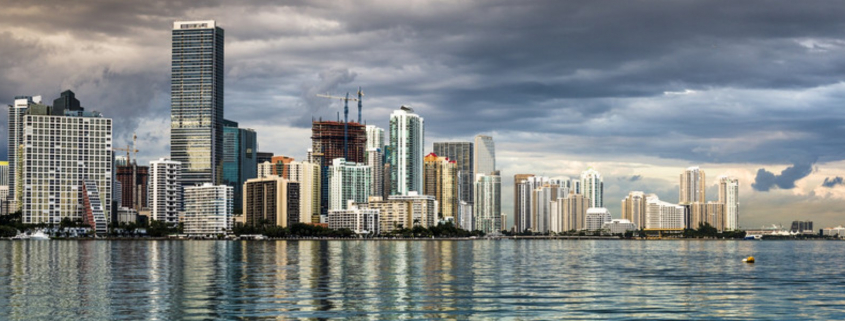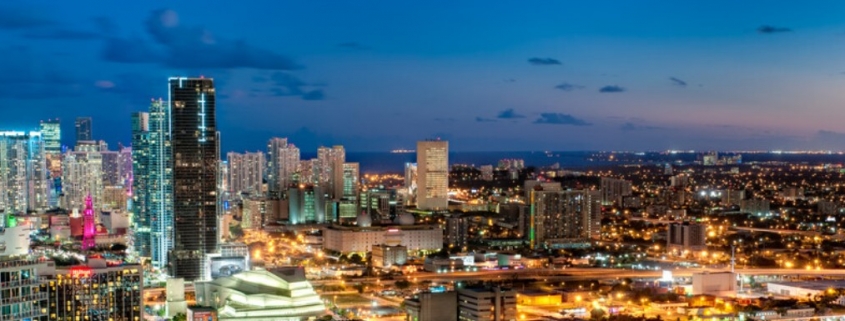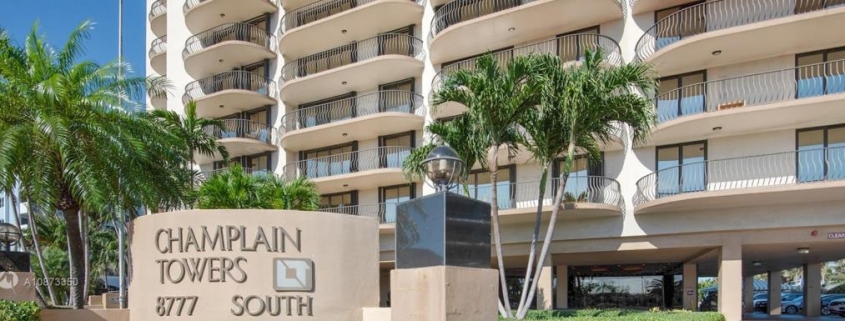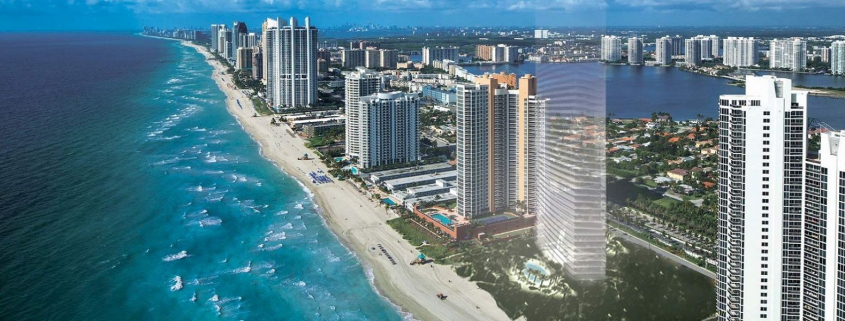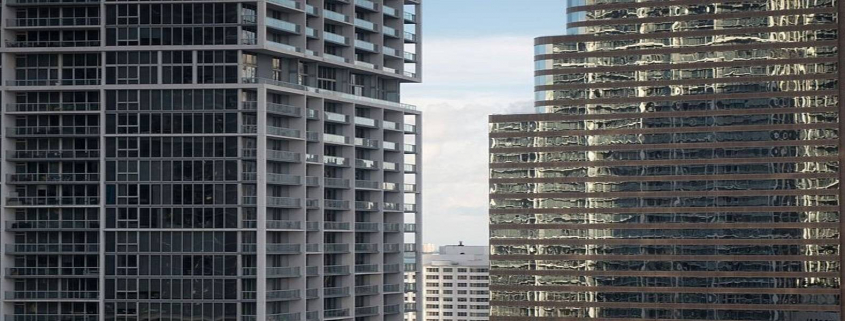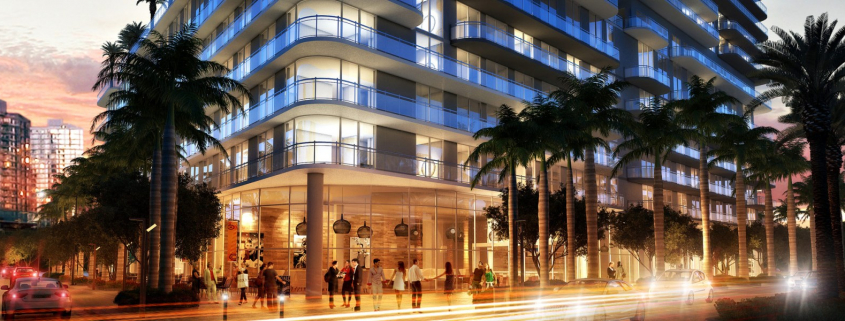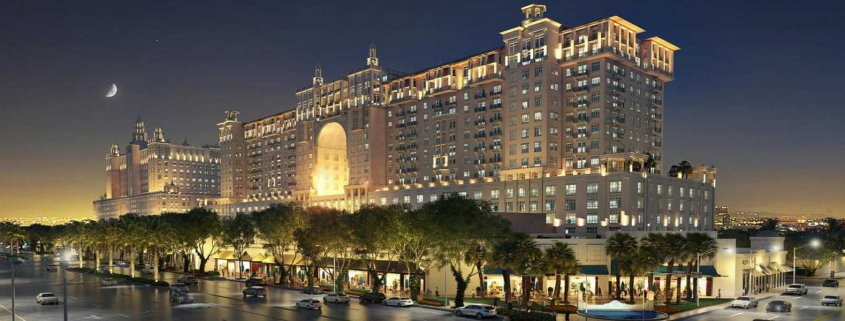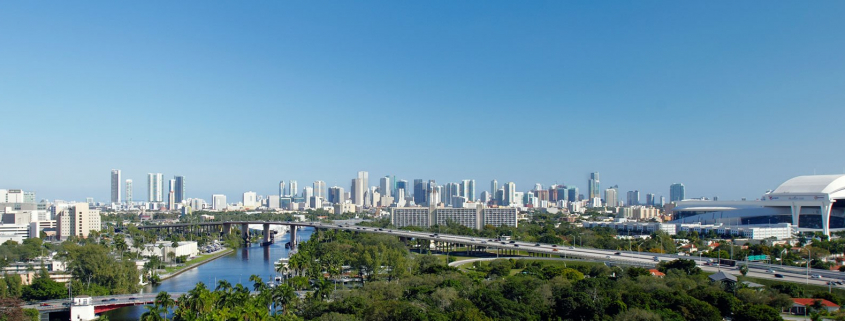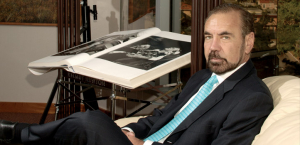If selected, construction would begin in 2023 and take 59 months to complete.
Posts
If approved, the development would not only be the largest residential development in Downtown Miami, it would also dwarf all the other projects in Miami Worldcenter, the master-planned project underway in Downtown Miami.
Related has made offers to unit owners at both Champlain Towers North and Champlain Towers East.
When iconic brands shake hands with real estate developers, there’s no limit to what they can achieve.
The Related Group and Dezer Development partnered with fashion designer Giorgio Armani, architecture firm Pelli Clarke Pelli and Swiss landscape architecture firm Enzo Enea to build Residences by Armani/Casa, a 308-unit luxury tower on the sands of Sunny Isles Beach in Miami. Recently, the developers paid off a $315 million construction loan to Wells Fargo and the 56-story building is nearing its planned $1 billion sellout.
Residences by Armani/Casa received its temporary certificate of occupancy and the first residents are ready to move into what the developers call a building that radiates opulence. Units range between 1,800 and 6,000 square feet, with prices starting at $2.9 million and going as high as $17 million. In an interview with Multi-Housing News, The Related Group Executive Vice President Jon Paul Perez and Dezer Development President Gil Dezer reveal details about the ultra-luxury condo project and their collaboration with the iconic brands.
M-HN: What’s the vision behind this project?
Perez: This building is the perfect combination of high fashion and five-star services and amenities, allowing homeowners to be immersed in luxury and enjoy ease of living. Our vision was to deliver a product that not only resonates with admirers of the Armani brand, but wows buyers with something they’ve never seen before and serves as an exemplar in the condo market.
M-HN: What is the current status of the development?
Perez: The project is now complete and move-in ready. Most of our homeowners are currently building out their units and we will also be offering turnkey residences later this spring.
M-HN: What features set Residences by Armani apart from other Miami developments?
Perez: The amenity spaces cover 35,000 square feet and are easily among the project’s most remarkable qualities. They sprawl two full floors and are entirely designed and furnished by the Armani/Casa Interior Design Studio, helmed by Giorgio Armani himself. Each area radiates opulence, from the Privé lounge on the lobby level, to the two-story spa with indoor and outdoor treatment rooms. Other standout common spaces include a private bar and restaurant, a state-of-the-art fitness center with yoga and Pilates, a club-inspired game room with billiards, dedicated children’s room, old Hollywood-inspired movie theater, private cigar room, temperature-controlled wine cellar and more.
M-HN: Tell us about the most challenging aspects of the development.
Perez: Designing a project of this caliber involved ensuring every intricate detail upholds the standard and quality that the Armani brand and both development teams embody. Achieving the level of precision and luxury we set out for was no easy feat, from the custom grand doors that just barely graze the ceiling to the Italian-imported fabric wall coverings in lieu of wallpaper. Finally seeing it come to fruition was an extremely proud moment for all teams involved.
M-HN: Residences by Armani/Casa is now debt free. What can you tell us about financing such a project?
Perez: This is a tremendous milestone for our team and is a key indicator of the project’s rapid sales success so far. Paying off this loan so quickly is not only unique, but it also shows the importance of a harmonious partnership, from developers to designers.
M-HN: The property recently received its temporary certificate of occupancy. How did that impact sales?
Dezer: Now that the building is tangible and our buyers and prospective buyers can physically tour the building and see the quality, we’ve seen a huge wave of sales from the U.S. and across the globe. We’re nearing 90 percent and we’re on track toward the planned $1 billion sellout.
M-HN: This project is among the last by Argentinian architect Cesar Pelli, the mastermind behind iconic buildings around the world. Tell us about the features of the tower that best illustrate Pelli’s architecture and design style.
Dezer: Cesar Pelli and his firm are renowned for their skyscraper designs and for creating distinct structures that stand out among the skyline. This is the first feature at Residences by Armani/Casa that screams Cesar Pelli. The others are the tower’s glassy and silky form and the glass façade designed to blend into the ocean below. Pelli is known for his striking works, which seamlessly integrate into their surroundings.
M-HN: How do you expect this project to impact the Miami condo market as a whole?
Dezer: The success of Residences by Armani/Casa and our Porsche Design Tower demonstrate that luxury branded developments do help differentiate from other luxury offerings on the market. Buyers, particularly in this market, have increasingly high standards of design and leisure.
M-HN: What other distinctive projects is Dezer Development pursuing?
Dezer: We’re very bullish on Sunny Isles Beach. In fact, we just got approvals to build what could be the tallest tower in Sunny Isles Beach. We are also working on plans for the Intracoastal Mall in North Miami Beach, but our main focus right now is to sell out the remaining units at Residences by Armani/Casa.
Source: Multi-Housing News
With many heavyweights sitting on their hands until the next cycle, the top condo developers of 2017 are outliers daring to build amid a market facing oversupply.
A line of eager real estate agents, architects, attorneys and industry insiders snaked out the double doors at the Pérez Art Museum Miami on a balmy Friday night in May.
In a scene reminiscent of the launch parties of 2014 and 2015, about 800 guests made their way through the museum and up to the crowded third-floor terrace of the museum that bears the name of Miami’s biggest condo developer, Related Group founder Jorge Pérez.
The event? Okan Development Group, a Turkish development firm making its debut in the Miami market, was launching its Okan Tower, a $300 million, 70-story hotel and condo project planned for Miami’s Arts & Entertainment District.
Not everyone on the long line made it inside, but the soiree — which included a Turkish jazz band and speeches from billionaire developer Bekir Okan, Miami Mayor Francis Suarez and One Sotheby’s International Realty President Daniel de la Vega — showed how hungry the real estate community was for a brand-new project, one that was free of the baggage of previous site plans, delayed timelines or lackluster sales.
Kasim Badak, CEO of Okan Development Group, acknowledged there is a clear slowdown in Miami’s condo market, but said he believes Okan Tower will be timed perfectly for the next cycle.
“The project will take about 40 to 45 months to build. By then, we will be in a great position to have a new project in the market,” Badak said.
If Okan breaks ground in the fourth quarter of this year, it would be delivered at some point in 2022, in time for what insiders say could be the start of the next cycle.
Okan is one of only a handful of developers to submit new permit applications for ground-up condo construction in Miami, Miami Beach, Aventura and Sunny Isles Beach over the past 12 months. The Real Deal analyzed applications filed in those cities between May 2017 and April 2018 and found that the developers forging ahead on condo projects included Aria Development, which ranked first, Okan Development Group which came in second, and third-place firm Multiplan Real Estate Asset Management, led by Brazilian billionaire José Isaac Peres.
The developers who’ve built some of the biggest Miami condo projects of this cycle — Related, JDS Development Group, Swire Properties and others — are keeping mum about future condo projects, focusing instead on selling out their current buildings and ramping up multifamily, mixed-use and other types of projects.
Swire, for example, recently hired ISG to take over the remaining sales at Brickell City Centre’s Reach and Rise condos, and it won’t release a timeline or details about phase two until it sells out those 198 remaining units, said Maile Aguila, Swire’s senior vice president of residential sales. Aguila doesn’t expect a sellout for another year and a half or two years — sometime between the end of 2019 and the beginning of 2020.
Others are proceeding boldly. Aria Development, for example, is working with Kuwait real estate company AQARAT to build YotelPad Miami, a 31-story tower planned for 227 Northeast Second Street in downtown Miami. Aria developer David Arditi joked that his firm likes to be different.
“Perhaps we’re a little contrarian in terms of market timing,” Arditi said.
But with YotelPad, Arditi and AQARAT are targeting a much lower price point than many developers sitting on unsold inventory. The building, a $150 million development, will have 208 condos and 250 Yotel “cabins,” or small hotel rooms.
“Sales launched about two months ago, with prices starting in the $300,000s,” Arditi said. “Condos range in size from about 417 square feet to 708 square feet. We saw an opportunity in the market that we felt was not being adequately addressed for branded residential product.”
YotelPad, which is 70 percent owned by the Al-Bahar family — the controlling shareholders of AQARAT — will manage the property. Aria and AQARAT are working to secure a construction loan for about half of the project cost, which comes to about $75 million. They’ll break ground in the fourth quarter of this year and complete the project in approximately two years.
“Sales skipped the reservation phase and went straight to contracts,” Arditi said.
He declined to state how many units are under contract, but said he’s “very pleased” with the number.
“Buyers so far are from South America, Europe and China, as well as from the U.S.,” Arditi said. “I would not have launched this project if it required selling million-dollar branded residences right now.”
Located just north of downtown Miami, Okan Tower will also be targeting non-luxury buyers, with units there starting at $318,500. In addition to a 294-room Hilton Hotel & Resorts-branded property, the tower will feature office space and a restaurant and bar on the 66th floor.
Badak of Okan said that the company launched sales in Istanbul in May, and has secured about 45 reservations from buyers in Turkey and in the U.S. Okan is self-financing the $300 million project.

Although it’s rare, there are some developers who will be putting more luxury condos on the market.
Multiplan Real Estate Asset Management is demolishing the Marlborough House property in Miami Beach, where it will build 5775 Collins Avenue, a boutique luxury condo building.
The Brazilian developer is building an on-site sales center. Marcelo Kingston of Multiplan declined to provide specific numbers, but said the 17-story, 89-unit project will be priced similarly to Eighty Seven Park, the Four Seasons Residences at the Surf Club and L’Atelier. Units in those properties generally range in price from at least $1.6 to $31 million.
The approval process wasn’t an easy one for Multiplan, which faced a delay from the city of Miami Beach, thereby pushing the project’s timeline back.
“But sales won’t dictate when the building gets completed,” Kingston said. “The December approval was a major trigger for the project to move forward.”
Now, the development team, which includes Arquitectonica, is pushing toward what they see as the next most optimal time to launch: Art Basel this December, the unofficial kickoff to Miami’s selling season.
And after launching last fall, Element Development plans to break ground on the first phase of Glasshaus in the Grove in June, then launch sales for phase two by the end of this year. The developer ranked fourth in TRD’s analysis of the biggest condo project developers of the past 12 months.
Element, led by Javier Lluch, has sold about half of the units in the first phase, a 23-unit condo development at 3161 Center Street. Element is building the project with G.D8, and Fortune International Group is handling sales and marketing.
“Sales are doing very well. We’re selling at about a third of the price of our competitors,” Lluch said.
Prices at Glasshaus start at $595,000.
Meanwhile, sales have not yet launched for 1414 West Avenue in Miami Beach. The development group, tied to Spencer Blank of Boca Raton firm Redcliff Builders and Belgian investors Axel Knauf and Bernard Petit, secured design approvals from the city of Miami Beach in October 2017.
UrvanX, a Miami-based architecture firm, is designing the five-story, 14-unit boutique condo building. The previous owner of the site won approvals for the building in 2015, but it didn’t obtain building permits within the allotted time frame. Units at 1414 West Avenue will range from 672-square-foot one-bedrooms to 1,315-square-foot two-bedrooms.
The development site is about two blocks north of Monad Terrace, a luxury condo building that JDS Development Group and partners are building.
“At Monad, units are under contract for more than $1,800 a foot,” developer Michael Stern said.
JDS, one of Miami’s largest condo developers in terms of number of units this cycle, has sites across South Florida, including some along the Miami River.
Stern declined to comment on future condo plans, but said that while he’s always watching the market, he’s careful not be too cautious.
“If you overreact to the specifics of the cycles in Florida, you can get caught with bad timing,” Stern said.
Source: The Real Deal
Next month, a swanky new hotel will debut in Midtown Miami, signaling what’s likely to be the start of a transformation for the downtown Miami corridor that, until only last year, was a lodging desert.
The addition of a condo/hotel project, Hyde Suites and Residences Midtown Miami, speaks to the growth of Midtown, which sits between the trending neighborhoods of Wynwood and the Design District.
Until last year, the area had no hotels and only a smattering of motels, though it was growing as a retail and real estate destination. In the last eight years alone, the population of Midtown has increased by about 50 percent, according to the Miami Downtown Development Authority.
Then in April 2017, a 151-room Hampton Inn opened at 3450 Biscayne Boulevard — the area’s first major hotel. This June, the 32-story Hyde will open, with 60 hotel suites and 410 luxury condos at 3401 NE First Ave. The project is the second condo/hotel for the Hyde brand, developed by The Related Group and hospitality company sbe, the team behind Hollywood Beach‘s 42-story Hyde. Dezer Development also worked on the Midtown Hyde.
“Midtown is a very interesting location,” said Carlos Rosso, president of the condominium development division at The Related Group. “It’s a really consolidated neighborhood with big sidewalks, with great ground for retail. Mid-priced shops and supermarkets make it a really nice neighborhood to live in. It’s why people have continued to move and buy in Midtown.”
They’ve started traveling there, too. According to the Greater Miami Convention and Visitors Bureau, which only started tracking visits to Midtown in 2015, nearly 4 percent of all visitors to Miami-Dade last year stopped in Midtown, the neighborhood’s highest figure yet. Its neighbors, Wynwood and the Design District, also saw growth. Nearly 17 percent of visitors went to Wynwood — almost twice as many as in 2016 — and 5.6 percent visited the Design District.
Location is a major draw for developers. Midtown offers travelers connectivity to downtown Miami and Miami Beach — but for a lower price. For the Hampton Inn, which has a year of being in Midtown under its belt, owner Bo Ashbel said those two factors are key to attracting visitors.
“It’s a very convenient place to stay. They are beginning to realize that there is a lot more to offer there and there is some pricing advantage, staying with us as opposed to staying in Brickell, which is quite pricier — and we have a brand new product,” Ashbel said. Rooms at the Hampton Inn in early June, for instance, start at $155.
Ashbel is betting on Midtown‘s success, so much so that he’s developing a second hotel, a 153-room AC Hotel by Marriott, which has already broken ground. It will open in fall 2019. Ashbel said other developers are in talks to build two or three more hotel projects in Midtown.
“What we are seeing already is a number of the neighboring properties to us, including those on our block, that are undergoing major renovations to reposition their own properties and upgrade them,” Ashbel said. “You are beginning to see the ripple effect. It reinforces the notion that this will become a legitimate submarket.”
The addition of the luxury Hyde will also play a major role. The development features condos between 760 and 1,868 square feet and a whole host of amenities, including on-demand housekeeping, a theater, a kids room, a state-of-the-art gym, tennis and bocce courts, and a heated pool and spa. On the ground level are 20,000 square feet of retail space.
The 32-story tower was designed by local firm Arquitectonica with interiors by David Rockwell, plus a curated selection of art from Mexican artists Bayrol Jimenez and Omar Barquet, Portuguese street artist Alexandre Farto and Danish artist Malene Landgreen.
Hyde has not yet announced the hotel’s room rates, but weekend rates in the Hollywood Beach Hyde in early June start at $263 a night. More than 94 percent of the residences at the Midtown property, which run from about $400,000 to $2 million, are already sold.
“We think that there are urban explorers that love hotels that are off the grid and we saw that this project had the right scale to appeal to them,” Rosso said.
Source: Miami Herald
Related Group and The Allen Morris Company are proposing a $250 million project to replace city-owned parking garages at 245 and 345 Andalusia Avenue in Coral Gables.
The project, called Coral Gables City Center, would have two 16-story towers and could be built in phases.
TOWER 1:
- 140,000 square feet of office space
- 11,871 square feet of ground-floor retail
- 770 parking spaces
TOWER 2:
- 270 residential units (either rental or condo)
- 16,878 square feet of ground-floor retail
- 799 parking spaces
Zyscovich is the architect. Related and Allen Morris are competing against another bid from ZOM and Terranova. Both were the finalists selected out of five bidders for the property, and the city commission will vote later this month.
Source: The Next Miami
An entrepreneur who’s bought a big chunk of downtown Miami while promising some mold-breaking surprises was apparently not kidding: He wants to build an eye-catching 49-story tower with apartments so small there’s no room for ovens in the tiny kitchens. And there’s no parking.
Actually, that last bit’s not quite right. There will be parking — for bicycles. Is Miami really ready for this?
Moving-company and arts mogul Moishe Mana — who’s also building a mini-city on a large swath of Wynwood and has lately spent tens of millions to buy up property on and around downtown’s Flagler Street — certainly thinks so.

A rendering of developer Moishe Mana’s proposed “micro-living” apartment tower. (Zyscovich Architects)
He’s the first in Miami to formally propose putting up a building consisting entirely of what’s been dubbed “micro-units” — compact, hyper-efficient and affordable apartments meant for young singles who want to live in dense urban neighborhoods and get around primarily on foot and public transit. The plan, which Mana’s team says fully conforms with downtown zoning rules, will have its first and likely only public review before the city’s Urban Design Review Board on Monday
 The blueprint calls for 328 apartments starting at 400 square feet, the minimum allowed by city code. The penthouse units top out at a relatively generous 600 square feet, but most will be 500 square feet and under, said the project’s architect, Bernard Zyscovich.
The blueprint calls for 328 apartments starting at 400 square feet, the minimum allowed by city code. The penthouse units top out at a relatively generous 600 square feet, but most will be 500 square feet and under, said the project’s architect, Bernard Zyscovich.
The apartments would be equipped with built-in furnishings, including beds and tables, that tilt, fold or slide into walls and cabinets, Zyscovich said. And the building, at 200 North Miami Ave., would be flush with amenities, including built-in superfast WiFi and fully equipped common kitchens and dining rooms for when residents want to entertain.
“It’s like living in a Transformer,” Zyscovich said. “The idea was, let’s make these apartments in the urban core, let’s make them small and let’s build in all the stuff that makes it desirable. We’re going for that authentic coolness that comes from being in the middle of everything. It’s for a particular type of person, probably Millenials but not exclusively so, who want to live an urban life and simplify their life, and not have all their money going to rent and furniture and maintaining a car.”
Rents, which have not been set, would be at market rates, but would be significantly lower than the norm downtown and in surrounding neighborhoods like Brickell — where high costs have some renters taking in roommates and doubling up in bedrooms — by virtue of the apartments’ small size. The substantial savings Mana will realize by not having to build costly structured parking will also help keep rents down, Zyscovich said.

A rendering of developer Moishe Mana’s proposed “micro-living” apartment tower. (Zyscovich Architects)
The project takes advantage of a zoning exemption that allows buildings close to transit stations in downtown Miami to dispense with parking. The building, on a sliver of land that Zyscovich said would make it hard to fit in a parking garage in any case, sits a short stroll from the Government Center Metrorail station, three Metromover stops and the station for the All Aboard Florida train service, now under construction.
There is lots to walk to nearby, including courthouses, government buildings and offices with tens of thousands of jobs, not to mention classes at Miami Dade College’s downtown campus two blocks away. The All Aboard station will have a food market, and Whole Foods and Publix stores can be reached by Metromover or city trolley.
Those who insist on having a car have options: The building site abuts a big city parking garage, and another public garage sits a couple of blocks away.
Two South Florida analysts predicted Mana will have no trouble renting out the building at a time where rents in Miami have risen much faster than salaries, creating a housing affordability crisis.
If Mana rents his apartments in the middle of the range for the area, or about $2.25 a square foot, that means someone could get into one of the 400-square-foot units for $900 a month, a relative bargain, while enjoying the privacy of his or her own space, noted Jack McCabe at McCabe Research in Broward County.
“They will fill it up,” McCabe said even as he expressed surprise at the apartments’ size and lack of fully equipped kitchens — though they will have cooktops. “Affordability is key right now. There is definitely demand for more-affordable rentals without a real kitchen in a cramped apartment that allows you to enjoy the lifestyle in downtown Miami.”
McCabe said the common kitchens, which Zyscovich said would have to be booked in advance, are a desirable feature for many people, and the compact units would not bother many of the South Americans and Europeans now flocking to the city who are used to living in smaller spaces than Americans.
The “micro-living” concept, which is catching on in other U.S. cities like Seattle, San Francisco and New York — the Big Apple’s first such building just opened in the Kip’s Bay neighborhood on the east side of Manhattan — can help solve not just the affordability problem but also relieve traffic congestion, said Suzanne Hollander, a broker and lawyer who teaches at Florida International University’s Hollo School of Real Estate.
“It’s very smart. It’s pioneering,” Hollander said. “Micro units are tiny solutions to big urban problems, and Miami is becoming a big urban city. It gives options to a lot of people who otherwise would not have them, so they can enjoy the urban living we are building.”
Micro-living buildings also carry other potential social benefits that could prove attractive not just to Millenials but also to retirees or business executives who need a pied-a-terre, she added.
“People sleep in a micro-unit. But, really, the whole building is their home,” Hollander said. “And the amenities here are amazing. What they’re trading is space for an A-plus location. This all encourages people to interact not just inside the building, but in the neighborhood, making everything more social.”
Another benefit, she said: Because the units are new and built to code, they are safer alternatives to the unregulated rooms in older homes or apartment houses that are often the only alternative for people on limited incomes.
Micro-units in New York and elsewhere are even smaller than Mana’s, with those in New York’s Carmel Place ranging from 260 to 360 square feet after the city waived its 400-square-foot minimum. That’s something some advocates are pushing to happen in Miami as well.
The no-parking alternative has a longer track record in Miami. Other developers have used the transit exemption to build no-parking residential towers downtown, including Related Group’s Loft buildings, but those units are for sale and tend to be larger. Units at Centro Miami, a high-rise condo tower now nearing completion, also without parking, range from 500 to over 1,111 square feet.
A new city zoning rule also allows for small buildings near transit routes to forgo parking. A small developer has broken ground on townhouse-like apartments without parking in East Little Havana.
Though Mana’s apartments will be small, the tower’s design aims to make a big impression, Zyscovich said. It looks like stacked blocks, with some sides on the west and south screened with a “veil” of metal mesh to shade them from the sun.
“It wants to say, I may filled with micro-units, but I’m cool,” the architect said.
Source: Miami Herald
Miami’s urban core markets generated $1.2 billion in retail property sales last year, with more than half of the total occurring in Brickell, downtown and Wynwood, according to a recent commercial real estate report prepared for the Commercial Industrial Association of South Florida.

From left to right: Moderator and Downtown Development Authority Executive Director Alyce Robertson, Tony Cho, Raymond Fort, Andrew Frey and Jon Paul Perez
The findings were made public Friday during a panel discussion sponsored by the association that featured Tony Cho of Metro 1, Raymond Fort of Arquitectonica, Andrew Frey of Tecela, and Jon Paul Perez of the Related Group.
On the leasing side, the Biscayne Boulevard corridor, Brickell, downtown Miami, the Design District, Midtown, MiMo, Little River and Wynwood accounted for a combined 10 million square feet of leased space. Vacancy rates range from as low as less than 2 percent in Brickell to 12 percent in the Design District.
Miami’s urban centers will continue to experience rapid growth in the commercial retail sector in 2016 as the market for luxury condo sales slows down, the panelists told audience members huddled inside an unfinished office suite at Three Brickell City Centre.
“There is going to be a slowdown and a correction in ultra high luxury,” Metro 1 founder and CEO Cho said. “I think we will see a shift in type of projects [getting built]. I see more infill, mixed use projects catering to millennials.”
Frey, Tecela’s principal, echoed Cho. “With waterfront luxury high-rise condos, there is going to be an oversupply and there is going to be a decline in value,” Frey said. “I don’t think that is any real surprise to anyone. That is separate from the rest of the real estate industry, including multifamily, retail and office. I think [those sectors] seem to be doing pretty well.”
The panelists specifically singled out the ongoing transformation of Wynwood, which has morphed from an artist-driven warehouse community into a thriving, hip retail and office neighborhood over the last decade. With the new zoning overlay that was approved for Wynwood last year by the city commission, the neighborhood is poised for even more growth once developers in the area complete new residential buildings.
“I most recently fell in love with Wynwood,” said Perez, a Related vice president. “I didn’t understand it until about a year ago. You get this real sense of a new neighborhood that is truly transforming and changing.”
Frey said the new zoning overlay is good because Wynwood developers can now build projects with more density. “You will have actual residents, locals and repeat customers that live in the neighborhood,” he said. “With the new rezoning, you have opened a fantastic development opportunity there.”
According to the association’s market report, Wynwood experienced $165 million in retail property sales volume in 2015 and the vacancy rate is right at 6 percent. The average lease price for retail space is just above $80 per square foot.
Source: The Real Deal
Miami billionaire Jorge Perez says an end to a U.S. economic embargo on Cuba could help turn Havana into a mecca for real estate investment.
Perez, who was born in Argentina to Cuban parents, oversees a global condo empire with $20 billion in assets as chairman of Related Group.
The U.S. Agriculture Coalition for Cuba, with more than 25 companies and farm trade associations, was created yesterday in Washington to urge repeal of a 1996 law that placed permanent sanctions on Cuba after Fidel Castro seized power in a communist revolution.
In an interview at his Miami office, Perez said he favors a lifting of the embargo even after Cuban exile groups organized protests in Miami’s Little Havana neighborhood last month to oppose President Barack Obama’s easing of restrictions in place for more than 50 years. “We should’ve opened our eyes a long time ago,” the 65- year-old said. “Opening up trade and the exchange of ideas would further the democratization of Cuba. Demand for second homes will be much bigger than the Bahamas, Puerto Rico or Dominican Republic.”
Obama’s move to end a half century-long estrangement with Cuba raises the prospect that American developers and hotel operators such as Marriott International Inc. and Hilton Worldwide Holdings Inc. may be able to enter the tourism-rich market only 90 miles (145 kilometers) from Florida’s coast. They face a long road of navigating a region with unclear property laws and government control, making it probable they will proceed with caution, Perez said.
Joint Ventures
Tourist arrivals to Cuba rose almost 12 percent year-over- year in October to 187,311 visitors, according to the Cuban National Statistics Office. About 2.9 million tourists visited the island in 2013, almost a third of them from Canada. The second-most visited Caribbean country behind the Dominican Republic, Cuba has about 200 hotels with at least 35,000 hotel rooms, according to Jones Lang LaSalle Inc.’s hotel group.
Perez said he visited the island two years ago, taking a charter flight after he wasn’t able to obtain a U.S. permit to fly his private plane. If an opening occurs, Perez said he’d be interested in creating joint ventures with Cuban companies to help cultivate an entrepreneurial class, teach people how to operate in a free market economy, and encourage them to keep income from the projects in Cuba to help the country grow. He’s also interested in getting involved in the restoration of historic Havana.
‘Condo King’
Perez crashed with the rest of real estate market in 2008. He regained his crown as Florida’s “Condo King” by building new projects with 50 percent deposits from foreign buyers. The Miami Art Museum was recast as the Perez Art Museum Miami before its opening last year after he pledged $35 million in cash and art.
Inside his office, Perez has a coffee mug stamped with Bill Clinton’s name and a photo of him standing next to Obama. Most of the campaign donations Perez and Related Group made in 2012 and 2014 elections went to campaigns of Democratic party members, according to OpenSecrets.org.
Obama last month used the limited flexibility allowed by the law to ease travel, trade and finance with Cuba. Still, the economic embargo, in place since the early 1960s, needs congressional action to remove the restraints. “I don’t think that Raul Castro is going to wake up tomorrow and call free, general elections,” he said. “The lifting of the embargo is going to be a fight, though not impossible. A lot of the farm states are clamoring to lift this thing so we can sell products to Cuba. You’re going to get a lot of economic pressure.”
Source: Financial Advisor Magazine
About Us
Ven-American Real Estate, Inc. established in 1991, is a full service commercial and residential real estate firm offering brokerage and property management services.
Subscribe
Contact Us
Ven-American Real Estate, Inc.
2401 SW 145th Avenue, Ste 407
Miramar, FL 33027
Brokerage & Property Management Services
Phone: 305-858-1188

